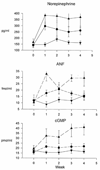Large animal models of heart failure: a critical link in the translation of basic science to clinical practice
- PMID: 19808348
- PMCID: PMC2762217
- DOI: 10.1161/CIRCHEARTFAILURE.108.814459
Large animal models of heart failure: a critical link in the translation of basic science to clinical practice
Abstract
Congestive heart failure (HF) is a clinical syndrome, with hallmarks of fatigue and dyspnea, that continues to be highly prevalent and morbid. Because of the growing burden of HF as the population ages, the need to develop new pharmacological treatments and therapeutic interventions is of paramount importance. Common pathophysiologic features of HF include changes in left ventricle structure, function, and neurohormonal activation. The recapitulation of the HF phenotype in large animal models can allow for the translation of basic science discoveries into clinical therapies. Models of myocardial infarction/ischemia, ischemic cardiomyopathy, ventricular pressure and volume overload, and pacing-induced dilated cardiomyopathy have been created in dogs, pigs, and sheep for the investigation of HF and potential therapies. Large animal models recapitulating the clinical HF phenotype and translating basic science to clinical applications have successfully traveled the journey from bench to bedside. Undoubtedly, large animal models of HF will continue to play a crucial role in the elucidation of biological pathways involved in HF and the development and refinement of HF therapies.
Conflict of interest statement
Jennifer A. Dixon, MD: None.
Francis G. Spinale, MD, PhD: None.
Figures




Comment in
-
Letter by Schmitto et al regarding article "Large animal models of heart failure: a critical link in the translation of basic science to clinical practice".Circ Heart Fail. 2010 Mar;3(2):e3; author reply e4. doi: 10.1161/CIRCHEARTFAILURE.109.930149. Circ Heart Fail. 2010. PMID: 20233986 No abstract available.
References
-
- American Heart Association. ACC/AHA 2005 guideline update for the diagnosis and management of chronic heart failure in the adult. Circulation. 2005;112:e154–e235. - PubMed
-
- Haghighi K, Kolokathis F, Pater L, Lynch RA, Asahi M, Gramolini AO, Fan GC, Tsiapras D, Hahn HS, Adamopoulos S, Liggett SB, Dorn GW, 2nd, MacLennan DH, Kremastinos DT, Kranias EG. Human phospholamban null results in lethal dilated cardiomyopathy revealing a critical difference between mouse and human. J Clin Invest. 2003;111:869–876. - PMC - PubMed
-
- Ginis I, Luo Y, Miura T, Thies S, Brandenberger R, Gerecht-Nir S, Amit M, Hoke A, Carpenter MK, Itskovitz-Eldor J, Rao MS. Differences between human and mouse embryonic stem cells. Dev Biol. 2004;269:360–380. - PubMed
-
- Reimer KA, Jennings RB. The “wavefront phenomenon” of myocardial ischemic cell death, II. Transmural progression of necrosis within the framework of ischemic bed size (myocardium at risk) and collateral flow. Lab Invest. 1979;40:633–644. - PubMed
-
- Reimer KA, Lowe JE, Rasmussen MM, Jennings RB. The wavefront phenomenon of ischemic cell death. I. Myocardial infarct size vs. duration of coronary occlusion in dogs. Circulation. 1977;56:786. - PubMed
Publication types
MeSH terms
Grants and funding
LinkOut - more resources
Full Text Sources
Other Literature Sources
Medical
Research Materials
Miscellaneous

